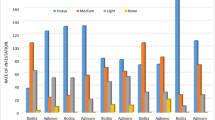Abstract
An unexpected mortality of more than 300 cattle was investigated near a metal recovery factory located in a rural area of the Thane district of India. The factory was engaged in reclaiming lead, aluminium, tin, and zinc from discarded lead storage batteries and soft drink cans. The environmental samples (soil, leaves, grass, slag, water, and sediment), human blood and hair and animal samples (blood, urine, peritoneal fluid, liver, kidney, cow dung, ribs, and femur), collected for analysis revealed toxic levels of lead, cadmium, and chromium. Clinical examination of factory workers and school children revealed cough, fever, gastric problems, abdominal pain, skin lesions (scabies), and blue line on gums. Histopathological examination of animal tissues revealed chronic pathology with lead inclusion bodies in hepatocytes and renal tubules. Based on environmental, clinical, analytical, and histopathological observations, the mortality has been attributed to toxic levels of metals in the body and the malnourished status of the animals.
Similar content being viewed by others
References
Allaway WH (1968) Agronomic controls over the environmental cycling of trace elements. Adv Agronomy 20:235–274
Bartik M, Piskac A (1981) Veterinary Toxicology. Elsevier Scientific Publishing Co, Oxford
Berman E (1980) Toxic metals and their analysis. Heyden Inc, London
Cicuttini FM, Fairley CK, McNeil JJ, Taylor ER (1994) The public health problem of environmental lead exposure. Med J Australia 160:178–181
Clarke EGC, Clarke ML (1967) Garners Veterinary Toxicology. Williams and Wilkins Co, Baltimore, MD
Connor EE, Scanlon PF, Kirkpatrik RL (1994) Bioavailability of lead from contaminated sediment in Northern Bobwhites, Colinus virginianus. Arch Environ Contam Toxicol 27:60–63
Dogra RKS, Shanker R, Saxena AK, Khanna S, Srivastava SN, Shukla LJ, Zaidi SH (1984) Air pollution: Significance of pulmonary dust deposits in bovine species. Environ Pollu (Ser A) 36:109–120
Dogra RKS, Shanker R, Saxena AK, Khanna S, Srivastava SN, Shukla LJ, Zaidi SH (1988) Pulmonary pathology and significance of particulate dust deposits in goats. Indian J Animal Sci 58:330–337
Dorn CR, Pierce JO, Chase GR, Phillips PE (1975) Environmental contamination by lead, cadmium, zinc, and copper in a new lead producing area. Environ Res 9:159–172
Goyer RS et al. (1970) Lead and protein content of isolated intranuclear inclusion bodies from kidneys of lead poisoned rats. Lab Invest 22:245–251
Hays FL (1976) Effects of various air pollutants on domestic animals. In: Johnson HD (ed) The effects of weather and climate on animals. Progr Biomaterial Div B Chap Swets & Zeitlinger, B.V. Amsterdam 7:209–226
Hsu FS, Krook L, Pond WG (1975) Interaction of dietary calcium with toxic levels of lead zinc in pigs. J Nutr 105:112–118
Kagi JHR, Shaffer A (1988) Biochemistry of metallothionein. Biochemistry 22:8510–8515
Krishna Murti CR, Viswanathan PN (1991) Toxic metals in Indian environment. Tata McGraw Hill, New Delhi, India, pp 75–121, 131–148
Leita L, Pardini G, Ferrari F, Sequi P (1990) Anomatous contents of heavy metals in soils and vegetation of a mine area of southwest Sardinia. Water Air Soil Pollut 48:423–433
Leita L, Enne G, De Nobili M, Baldini M, Sequi P (1991) Heavy metal bioaccumulation in lamb and sheep bred in smelting and mining areas of Southwest Sardinia (Italy). Bull Environ Contam Toxicol 46:887–893
McManus JFA, Mowry RW (1965) Staining methods: Histological and histochemical. Harper and Row, NY
Morrison JN, Qarterman H, Humphries WR (1977) The effect of dietary calcium and phosphate on lead poisoning in lambs. J Comp Pathol 87:417–429
Munro IC, Charbonneau SM (1981) Environmental contaminants. In: Roberts HR (ed). Food Safety. Intern Pub, New York, pp 161–164
Palmer KT, Kucera CL (1980) Lead contamination of sycamore and soil from lead mining and smelting. J Environ Quality 9:106–112
Randhawa CS, Randhawa SS, Gupta PP, Rathor SS (1989) Histological studies in paddy straw induced alkaline indigestion in buffalo calves. National symposium on emerging diseases in livestock due to environmental pollution, October 4–6, Indian Veterinary Research Institute, Izatnagar, India
Rastogi SK, Frankling SB, Awasthi AK, Husain T, Chandra SV (1988) Scalp hair analysis for metals in green bangle workers. Indian J Occup Hlth 28:75–79
Reif JS, Ameghino E, Aaronson J (1989) Chronic exposure of sheep to a zinc smelter in Peru. Environ Res 49:40–49
Revich BA (1994) Lead in hair and urine of children and adults from industrialized areas. Arch Environ Hlth 49:56–62
Romieu I, Palazuelos E, Anita MH, Rios C, Munoz I (1994) Sources of lead exposure in Mexico city, Environ Hlth Perspect 102:384–389
Shakeel A, Chandra SV, Ray PK (1987) ITRC Manual for Metal Analysis in Water, ITRC Manual No. 2. Industrial Toxicology Research Centre, Lucknow, India
Singh B, Dhawan D, Garg ML, Mangal PC, Chand B, Trehan PN (1994) Impact of lead pollution on the status of other trace metals in blood and alterations in hepatic functions. Biol Trace Elemen Res 40:21–30
Smith HA, Jones TC, Hunt RD (1972) Lead. In: Veterinary Pathology (Indian Edition) Lea and Febiger, Philadelphia, pp 956–961
Srivastava AK, Bheari V, Mathur N, Pangty BS, Gupta BN (1993) Estuarine pollution—A health perspective. Indian J Environ Protec 13:561–564
USA H&HS (1993) Toxicological Profile Lead. U.S. Dept. Health and Human-Public Health Service, Agency for Toxic Substances and Disease Registry, Atlanta, GA, pp 136–138
Willoughby RA, McDonald E, McSherry BJ (1972) Lead and zinc poisoning and the interaction between lead and zinc poisoning in foal. Canad J Comp Med 36:348–359
Zimdahi RL, Hassett JJ (1979) Lead in soil. In: Boggers WR, Wixson BG (eds) Lead in the environment. Castle Houx Pub Ltd, Austin, TX, pp 99–104
Author information
Authors and Affiliations
Rights and permissions
About this article
Cite this article
Dogra, R.K.S., Murthy, R.C., Srivastava, A.K. et al. Cattle mortality in the Thane district, India: A study of cause/effect relationships. Arch. Environ. Contam. Toxicol. 30, 292–297 (1996). https://doi.org/10.1007/BF00215811
Received:
Revised:
Issue Date:
DOI: https://doi.org/10.1007/BF00215811




